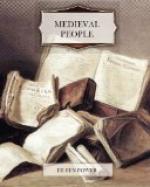The knowledge which Marco Polo had thus brought to Europe, the intercourse between East and West which his experience had shown to be so desirable, continued to grow after him. Merchants and missionaries alike travelled by land or sea eastward to Cathay.[38] Another of those indomitable Franciscan friars, John of Monte Corvino, went out at the age of fifty and became Archbishop of Peking. Churches and houses of friars were founded in some of the Chinese cities. Odoric of Pordenone, another friar, and a very good observer too, set forth in 1316 and sailed round India and through the Spice Islands by the same sea route by which the Polos had brought their Tartar princess back to Persia, and so reached Canton, ’a city as big as three Venices ... and all Italy hath not the amount of craft that this one city hath.’ He left a wonderful account of his travels in China, including descriptions of Peking and Hangchow, and ends his stories with the words, ’As for me, from day to day I prepare myself to return to those countries, in which I am content to die, if it pleaseth Him from whom all good things do come’—no doubt where he had left his heart, but he died at Udine in Italy. Later there went out another friar, John Marignolli, who was Papal Legate to Peking from 1342 to 1346.
Nor was it only missionaries who went to Cathay. Odoric, speaking of the wonders of Hangchow, refers for confirmation to Venetian traders who have visited it: ’’Tis the greatest city in the whole world, so great indeed that I should scarcely venture to tell of it, but that I have met at Venice people in plenty who have been there’; John of Monte Corvino was accompanied by Master Peter of Lucolongo, ‘a great merchant,’ and John Marignolli mentions a fondaco for the use of Christian merchants, which was attached to one of the Franciscan convents at Zaiton. Above all, there is Francis Balducci Pegolotti, that intrepid factor who served the great commercial house of the Bardi of Florence, and who wrote a priceless handbook for the use of merchants about 1340. In this he gives detailed instructions for the guidance of a merchant, who wishes to proceed from Tana on the Black Sea by the overland route across Asia to Cathay and back again with L12,000 worth of silk in his caravan, and remarks casually, in passing, ’The road you travel from Tana to Cathay is perfectly safe, whether by day or night, according to what merchants say who have used it’—’il




